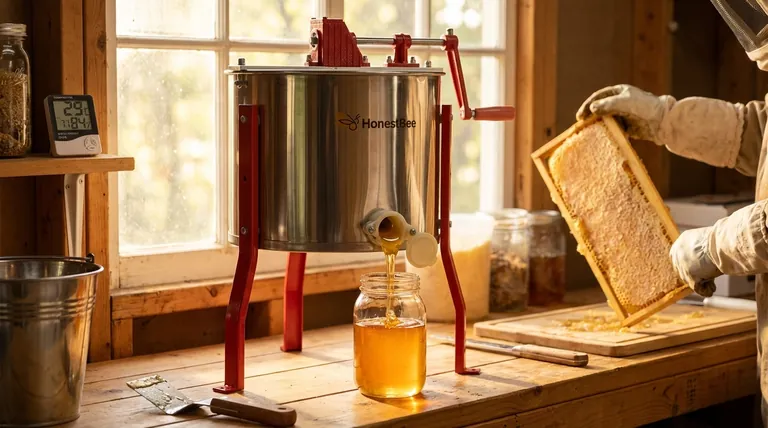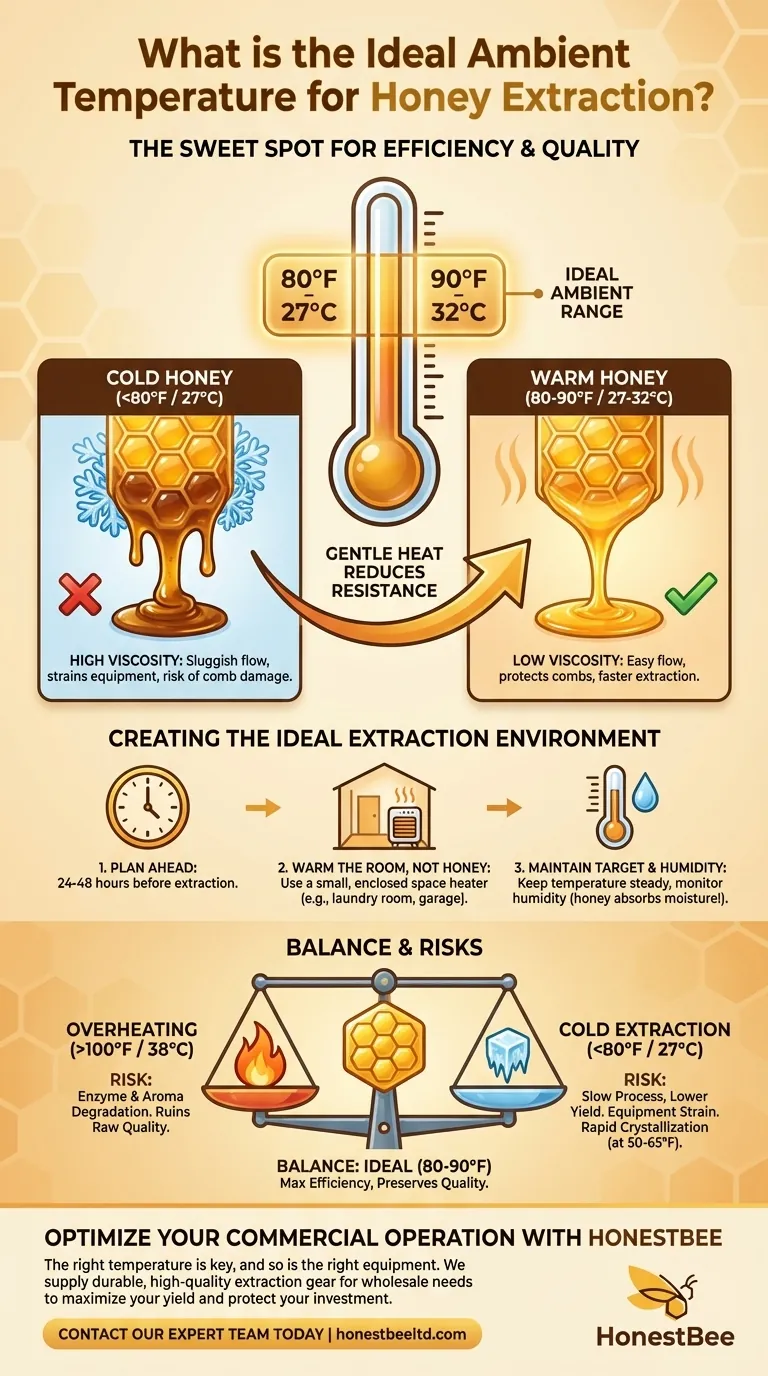The ideal ambient temperature for honey extraction is between 80-90°F (27-32°C). This warmth is not strictly required to get the job done, but it is the key to an efficient and effective process. The primary goal of managing temperature is to decrease the honey's viscosity, making it flow far more easily from the comb.
The core principle is simple: warm honey flows like water, while cold honey flows like molasses. Your goal isn't to hit an exact number on a thermometer, but to create an environment where the honey is fluid enough to move easily through every stage of extraction, from the comb to the bottle.

The Physics of Honey: Why Temperature is Crucial
Honey's resistance to flow is a property called viscosity. For the beekeeper, viscosity is the single greatest physical challenge during extraction. Understanding how to manage it is fundamental to a smooth harvest.
Viscosity is the Key Factor
Honey is a supersaturated sugar solution, which makes it naturally thick and sticky. At cooler temperatures, the sugar molecules are sluggish and clump together, resulting in extremely high viscosity. This makes the honey difficult to remove from the comb and hard to strain.
How Heat Reduces Viscosity
Gently warming the honey gives its molecules more energy. This allows them to move more freely and slide past one another with less resistance. The result is a dramatic reduction in viscosity, transforming the honey from a thick, stubborn mass into a much more cooperative liquid.
The Impact on Your Equipment
Extracting cold, thick honey places significant strain on your equipment. An extractor's motor will have to work much harder, and the rotational force required to pull the honey from the cells can be so high that it can damage or "blow out" the delicate wax combs, which you want to preserve for the bees to use again.
Creating the Ideal Extraction Environment
Your "hot room" doesn't need to be a high-tech chamber. The goal is simply to warm the supers of honey before you begin working with them.
The Target Range: 80-90°F (27-32°C)
This temperature range is the sweet spot. It's warm enough to make the honey highly fluid for easy uncapping, extracting, and straining. At the same time, it is cool enough that it will not damage the delicate enzymes and aromatic compounds that give raw honey its unique character and health benefits.
What If You Can't Reach 80°F?
If your environment is cooler, you can still extract honey, but you must adjust your expectations. The process will be slower, more physically demanding, and less efficient. You will likely leave more honey behind in the combs and spend significantly more time waiting for it to pass through your filters.
Practical Heating Methods
The safest way to warm your honey is to warm the room, not the honey directly. Place your supers in a small, enclosed room (like a laundry room or spare bathroom) 24-48 hours before extraction. Use a small space heater with a thermostat to maintain the target temperature. A non-air-conditioned garage on a hot day can also work perfectly.
Understanding the Trade-offs and Risks
While warmth is your ally, excessive or uncontrolled heat can ruin your harvest. It's a balance between efficiency and quality.
The Danger of Overheating
Never apply direct heat to your honey or let the ambient temperature climb above 100°F (38°C). High temperatures begin to degrade the beneficial enzymes, like diastase and invertase, and can drive off the subtle floral aromas, fundamentally altering the honey's flavor and quality.
The Problem with Cold: Post-Extraction Crystallization
After you have extracted, it's important to understand what happens when honey cools down. The optimal temperature range for honey to crystallize is between 50-65°F (10-18°C). If you allow your freshly extracted honey to sit at these temperatures, it will begin to solidify rapidly. Keeping it warm until it is in its final bottles helps delay this process.
The Role of Humidity
Be mindful of humidity in your extraction space. Honey is hygroscopic, meaning it will absorb moisture from the air. High humidity can increase your honey's water content above the safe level of ~18%, creating a risk of fermentation during storage.
Making the Right Choice for Your Goal
Your approach to temperature control depends on your priorities for the harvest.
- If your primary focus is speed and maximum yield: Preparing a dedicated "hot room" at 80-90°F is the most important step you can take for an efficient harvest.
- If your primary focus is simplicity with a small harvest: Extracting on a warm summer day in a closed room will suffice, but be prepared for a slower process and more effort.
- If your primary focus is preserving raw honey quality: Gently warm the room to the low end of the ideal range (around 80°F) and avoid any form of direct heating to protect the honey's delicate enzymes and aroma.
Ultimately, managing temperature is about making the physics of honey work for you, not against you.
Summary Table:
| Factor | Ideal Condition | Purpose & Benefit |
|---|---|---|
| Ambient Temperature | 80-90°F (27-32°C) | Reduces honey viscosity for easy extraction and straining. |
| Heating Method | Warm the room, not honey directly. | Protects honey quality; prevents enzyme degradation. |
| Risk of Overheating | Avoid temperatures >100°F (38°C) | Preserves delicate enzymes, aromas, and raw honey quality. |
| Risk of Cold Extraction | Slower process, lower yield, strain on equipment. | Prevents comb damage and maximizes honey recovery. |
Ready for a smoother, more efficient honey harvest?
At HONESTBEE, we understand the precise needs of commercial apiaries and beekeeping equipment distributors. The right temperature is key to your operation's success, and having the right equipment is just as critical.
We supply high-quality, durable honey extraction equipment and beekeeping supplies designed for the demands of wholesale operations. Our products help you maintain the ideal conditions for a high-yield, quality harvest while protecting your valuable comb and honey.
Let us help you optimize your process. Contact our expert team today to discuss your wholesale supply needs and discover how HONESTBEE can support your business's growth and efficiency.
Visual Guide

Related Products
- 2 Frame Stainless Steel Manual Honey Spinner Extractor for Beekeeping
- 6 Frame Manual Stainless Steel Honey Extractor Beekeeping Equipment
- HONESTBEE 3-Frame Manual Acrylic Honey Extractor
- Electric 8 Frame Honey Spinner Extractor Equipment for Beekeeping
- HONESTBEE 8 Frame Electric and Manual Three Use Honey Extractor
People Also Ask
- What are the consequences of leaving honey in an extractor? Protect Your Honey Quality and Equipment
- How do beekeepers harvest honey from the honey super? A Step-by-Step Guide to Efficient Extraction
- How can a pressure washer be used to clean a honey extractor? A Guide to Safe and Efficient Cleaning
- How often should a honey extractor be cleaned if used multiple times a year? Optimize Your Harvest Workflow
- What are some tips for using a honey extractor effectively? Maximize Your Honey Yield and Protect Your Comb



















